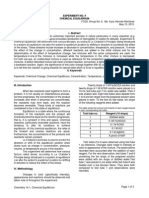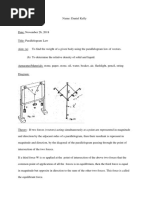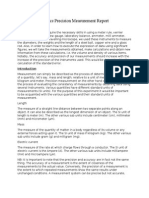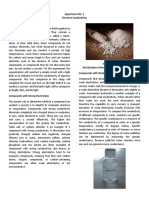Physics Lab Report 9
Physics Lab Report 9
Uploaded by
Lemuel ValerioCopyright:
Available Formats
Physics Lab Report 9
Physics Lab Report 9
Uploaded by
Lemuel ValerioOriginal Description:
Original Title
Copyright
Available Formats
Share this document
Did you find this document useful?
Is this content inappropriate?
Copyright:
Available Formats
Physics Lab Report 9
Physics Lab Report 9
Uploaded by
Lemuel ValerioCopyright:
Available Formats
Experiment 9: Study of Leenses
Lemuel Valerio, Cynthia Villegas, Rich Renvic Vito, Lizlane Zamora
Department of Math and Physics
College of Science, University of Santo Tomas
Espaa, Manila Philippines
Abstract
This experiment is about the different
effects of light on the lens to form an image.
The location and size of an image can be
determined graphically, by means of the
behavior of three characteristic rays. The
thin lens equation, ,1-.=,1-.+,1-., was
used by our group to compute for the focal
length of the lens for chromatic aberrations.
Results from the gathered data are the key
factors that will give the most possible value
of the effect being determined in the
experiment.
I. Introduction
This experiment is about the different
effects of light on the lens to form an image.
The location and size of an image can be
determined graphically, by means of the
behavior of three characteristic rays. The thin
lens equation, ,1-.=,1-.+,1-., was used
by our group to compute for the focal length
of the lens for chromatic aberrations. Results
from the gathered data are the key factors that
will give the most possible value of the effect
being determined in the experiment.
II. Theory
The focal length of an optical system
is a measure of how strongly the system
converges or diverges light. For an optical
system in air, it is the distance over which
initially collimated rays are brought to a
focus. A system with a shorter focal length
has greater optical power than one with a long
focal length; that is, it bends the rays more
strongly, bringing them to a focus in a shorter
distance.
The thin lens equation is stated as
follows :
wherein :
do = the distance from the object to the center
of the lens
di = the distance (measured along the axis)
from the image to the center of the
lens
f = the focal length of the lens
Real images will be projected on a
screen placed at the image position.The image
distance di is positive for a real image. The
image would also be inverted because it is
formed behind the lens. Virtual images can
not be projected on a screen placed at the
image position.The image distance di is
negative for a virtual image. The image would
also be upright because it is formed in front of
the lens. As the object moves closer to the
focal point, the image size increases.
An aberration is any failure of a mirror
or lens to behave precisely. It can be classified
as chromatic aberrations, which involve
wavelength-dependent imaging behavior, or
mono-chromatic aberrations, which occur
even with monochromatic (single-wavelength) light. Lens aberrations are not caused
by faulty construction of the lens, such as
irregularities in its surfaces, but are inevitable
consequences of the laws of refraction at
spherical surfaces.
Chromatic aberrations are a result of
dispersion, the variation of index of refraction
with wavelength. Dispersion causes the focal
length of a lens to be somewhat different for
different
wavelengths,
so
different
wavelengths are imaged at different points.
The magnification of a lens also varies with
wave- length; this effect is responsible for the
rainbow-fringed
images
seen
with
inexpensive binoculars or telescopes. Mirrors
are inherently free of chromatic aberrations,
which is one of the reasons for their
usefulness in large astronomical telescopes.
Spherical aberration is the failure of
rays from a point object on the optic axis to
converge to a point image. Instead, the rays
converge within a circle of minimum radius,
called the circle of least confusion, and then
diverge again. The corresponding effect for
points off the optic axis produces images that
are comet-shaped figures rather than circles;
this is called coma. Note that decreasing the
size of the lens aperture cuts off the largerangle rays, thus decreasing spherical
aberration.
III. Methodology
Figure 1 : Experimental set-up for the determination of
the focal length of the convex lens
Figure 2 : Experimental set-up for characterizing the
image formed by a convex lens.
Figure 3 : Experimental set-up for the determination of
the
focal length using a lens with chromatic aberration
Figure 4 : Experimental set-up for the determination of
the
focal length using a lens with spherical aberration
In the first activity, the rays of the sun on a
very distant object was allowed to fall on the
lens. The screen was moved back and forth
until the clearest image is formed on the
screen. The distance from the lens to the
image was measured and recorded as
the focal length.
In
the second activity, the image is
characterized as to whether it is real or
virtual, inverted or upright, and
magnified or diminished, by placing
the convex lens away from the source
of light at a distance of more than
twice the focal length. The convex
lens was placed away from the source
of light exactly twice the focal length,
between one focal length and twice the
focal length, exactly one focal length,
and less than one focal length. In each
set-ups, the image was characterized
and the distances was recorded.
In the third activity, the focal length was
determined using the thin lens
equation in two situations. In the first
situation, the source of light was
replaced by a blue bulb and then a red
bulb. In each source of light, the
distance of the bulb from the lens and
the distance of the image from the lens
was measured. In the second situation,
light was allowed to pass only through
the edges of the convex lens by
covering its center with a circular
piece of black paper. The distances of
the bulb from the lens and the sharp
image from the lens was measured.
Afterwards, the light was allowed to
pass only through the center of the
lens by cutting a circular piece of
black paper having the same size as
the lens with a hole at the middle. The
distances of the bulb from the lens and
the sharp image from the lens was
also measured.
IV. Results and Discussion
Activity 1
Focal length of lens = 32cm.
We computed for the focal length by looking
at a very distant object, in our case, the trees
in the plaza mayor. We moved it back and
forth until we can see the clearest image
formed on the screen. We then measured the
distance from the lens to the image and
recorded it as the focal length.
Activity 2
Table 1. Image Formation by a Convex Lens
Object Distance
Type of Image
Formed
More than twice the
Inverted, real, smaller
focal length
Exactly twice the
Inverted, real, same
focal length
Between one focal
Inverted, real, bigger
length and twice the
focal length
Exactly one focal
Upright, virtual, same
length
size
Less than one focal
Upright, virtual,
length
bigger
Image
Distance(cm)
Focal
Length(cm)
63
86
31.5
32.4
Using the electric lamp with a blue/red bulb,
adjust the screen until the clearest image is
formed. Then, measure the distance of the
bulb from the lens as well as the distance of
the image from the lens. Use the focal length
of the lens formula 1/f = (1/p+1/q) to yield the
answer.
Activity 4-B
Table 2.2 Spherical Aberrations
Outer Zone Middle Zone
Uncovered
Uncovered
Object
53
58
Distance(cm)
Image
81.5
74.5
Distance(cm)
Focal
32.1
32.6
Length(cm)
Position the lens between the bulb and the
screen. Cover the middle zone of the lens
used in activity one such that light only passes
through the edges. Adjust the screen until you
get the clearest image formed. Repeat the
steps for the 2nd time around but covering the
edges of the circle. Compute for the focal
length using 1/f = (1/p + 1/q)
Source of light was placed in a single spot.
Then the zero mark end of the meter stick was
placed where the source of light is to be
found. Using the focal length that is obtained
from the 1st activity as the basis, different
types of images will be formed depending on
where you will place the object. Simply
follow the given distance and different images
will be formed. Repeating the process and
changing the distance will yield different
types of images just as the results that were
gained.
V. Conclusion
Activity 4-A
Table 2.1 Lens Aberrations Using Blue/Red
Bulb
Blue Bulb
Red Bulb
Object
63
52
Distance(cm)
The third activity was in two parts, chromatic
and
spherical
aberration.
Chromatic
aberration made use of the red and blue
filters. A lens will not focus different colors in
exactly the same place because the focal
length depends on refraction and the index of
In this experiment, three activities
were done for lens aberrations. The first
activity is to obtain the focal length of the
lens.
The second activity made use of the same
lens; with the use of a bulb and meter stick,
the image formed on the wall was determined
real or virtual, inverted or upright, magnified
or diminished in varied distances.
refraction for blue light (short wavelengths) is
larger than that of red light (long
wavelengths). The amount of chromatic
aberration depends on the dispersion of the
glass. Spherical aberration was done by
covering certain parts of the lens. For lens
with
spherical
aberration,
the
best
approximation to use for the focal length is
the distance at which the difference between
the paraxial and marginal rays is the smallest.
In the end of the activity, the focal length of a
converging lens was determined; the image
formed by a converging lens in different
distances was characterized, chromatic and
spherical aberrations were verified and the
image formation by combination of lenses
were characterized.
VI. Applications
1. Pinhole glasses are said to improve clarity
of vision, when the concept of principal focal
length is used, the presumption is that all
parallel rays focus at the same distance, which
is of course true only if there are no
aberrations. For a lens with spherical
aberration, the best approximation to use for
the focal length is the distance at which the
difference between the paraxial and marginal
rays is the smallest. It is not perfect, but the
departure from perfect focus forms what is
called the "circle of least confusion".
Spherical aberration is one of the reasons why
a smaller aperture on a camera lens will give a
sharper image and greater depth of field since
the difference between the paraxial and
marginal rays is less.
http://hyperphysics.phyastr.gsu.edu/hbase/geoopt/aber.html#c1
2. To reduce fatigue, the focus (lens) of the
eyes must be shifted to a more distant object.
For example while reading a book, the lens in
the eyes must focus at a constant distance for
long periods of time, the muscle will become
strained, to reduce that, focus on far/near
objects to de-strain the muscles.
http://hyperphysics.phyastr.gsu.edu/hbase/geoopt/aberrcon.html
3. The lens of the eye is a convex lens; the
normal eye forms an inverted image on the
retina.
Farsightedness or hyperopia is the inability of
the eye to focus on nearby objects. The
farsighted eye has no difficulty viewing
distant objects. But the ability to view nearby
objects requires a different lens shape.
Farsightedness can be corrected by the use of
a converging lens. Light refracts before
reaching the cornea and is subsequently
focused on the retina. Nearsightedness or
myopia is the inability of the eye to focus on
distant objects. The nearsighted eye has no
difficulty viewing nearby objects. But the
ability to view distant objects requires that the
light be refracted less. Nearsightedness can be
corrected by the use of a diverging lens. Light
diverges before reaching the cornea and is
then converged to a location on the retina.
VII. References
http://www.physicsclassroom.com/class/refrn/
Lesson-6/Farsightedness-and-its-Correction
http://www.physicsclassroom.com/class/refrn/
Lesson-6/Nearsightedness-and-its-Correction
http://dev.physicslab.org/Document.aspx?
doctype=3&filename=GeometricOptic
s_ThinLensEquation.xml
http://www.ux1.eiu.edu/~cfadd/1160/Ch24M
L/ImgLen.html
http://wps.aw.com/wps/media/objects/877/89
8586/topics/topic12.pdf
http://dev.physicslab.org/Document.aspx?
doctype=3&filename=GeometricOptic
s_ThinLensEquation.xml
http://www.ux1.eiu.edu/~cfadd/1160/Ch24M
L/ImgLen.html
http://wps.aw.com/wps/media/objects/877/89
8586/topics/topic12.pdf
You might also like
- Simple Pendulum Lab ReportDocument7 pagesSimple Pendulum Lab Reportcm746569% (13)
- 5EC4-05 - Microwave Theory & Techniques - Harshal NigamDocument421 pages5EC4-05 - Microwave Theory & Techniques - Harshal Nigamphilwaren515No ratings yet
- Acceleration Due To Gravity Lab ReportDocument7 pagesAcceleration Due To Gravity Lab ReportLuka Vonier100% (2)
- Experiment 6: Specific Heat of Metals Laboratory ReportDocument8 pagesExperiment 6: Specific Heat of Metals Laboratory ReportIson Dy60% (5)
- Viscosity Lab ReportDocument13 pagesViscosity Lab ReportBASEKI JANI100% (4)
- Physics Lab Report - Refractive IndexDocument8 pagesPhysics Lab Report - Refractive Indexmy_jidapas58% (12)
- Viscosity LabDocument5 pagesViscosity LabMyeisha WilliamsNo ratings yet
- Physics - Lab # 10 Specific Heat CapacityDocument3 pagesPhysics - Lab # 10 Specific Heat CapacityDajuNo ratings yet
- Experiment 1: Errors, Uncertainties and Measurements Laboratory ReportDocument8 pagesExperiment 1: Errors, Uncertainties and Measurements Laboratory ReportIson DyNo ratings yet
- Physics Report - Snell's Law (Refraction)Document4 pagesPhysics Report - Snell's Law (Refraction)Martine Gjermundsen Ræstad94% (18)
- Chem ReportDocument6 pagesChem ReportBramwel Mbogo100% (17)
- Lab 3 - Newton's Law of CoolingDocument5 pagesLab 3 - Newton's Law of Coolingbilly100% (4)
- Lab Report (Archimedes's Principle)Document3 pagesLab Report (Archimedes's Principle)Inderjit Singh100% (1)
- Lab Report Hooke's LawDocument8 pagesLab Report Hooke's LawLeila JakupovicNo ratings yet
- Chem. 14.1 - Expt. 9 Chem Lab Report - Chemical EquilibriumDocument3 pagesChem. 14.1 - Expt. 9 Chem Lab Report - Chemical EquilibriumRomi Necq S. Abuel40% (5)
- Experiment 1: Errors, Uncertainties and Measurements Laboratory ReportDocument8 pagesExperiment 1: Errors, Uncertainties and Measurements Laboratory ReportEmman CervantesNo ratings yet
- CAPE Unit1 Physics Lab #5 Parallelogram LawDocument9 pagesCAPE Unit1 Physics Lab #5 Parallelogram LawDaniel Kelly67% (3)
- Lab Report Ice - LFDocument5 pagesLab Report Ice - LFRut H. P. EkasiwiNo ratings yet
- Visual Observation of Alkali Metals ReportDocument2 pagesVisual Observation of Alkali Metals ReportGeoffrey Gitere100% (2)
- Formal Lab ReportDocument4 pagesFormal Lab ReportBren SisonNo ratings yet
- Experiment 3: Conditions For EquilibriumDocument8 pagesExperiment 3: Conditions For EquilibriumToni Andrei CervalesNo ratings yet
- Diffusion Lab ReportDocument6 pagesDiffusion Lab ReportAmman ChuhanNo ratings yet
- Lab Report Physics 1Document18 pagesLab Report Physics 1Nisa AzrinNo ratings yet
- LAB REPORT - Determination of Concentration Acetic Acid in VinegarDocument12 pagesLAB REPORT - Determination of Concentration Acetic Acid in Vinegarhisham100% (4)
- Ultra-Violet Rays As Aid To RestoreresDocument7 pagesUltra-Violet Rays As Aid To RestoreresAafke WellerNo ratings yet
- Physics Laboratory Experiment 9Document4 pagesPhysics Laboratory Experiment 9Kristella DraheimNo ratings yet
- Reflection of LightDocument4 pagesReflection of LighthelenNo ratings yet
- The Vernier and Micrometer Calipers Physics Formal ReportDocument4 pagesThe Vernier and Micrometer Calipers Physics Formal ReportJim Asenci100% (1)
- My Final Report On Viscosity of A LiquidDocument8 pagesMy Final Report On Viscosity of A LiquidKuo Sarong100% (1)
- LAB REPORT Index of RefractionDocument6 pagesLAB REPORT Index of RefractionMd. Safiqul IslamNo ratings yet
- Kinetic Friction: Experiment #13Document8 pagesKinetic Friction: Experiment #13kate anne del castroNo ratings yet
- Lab Report 5Document8 pagesLab Report 5Nashrul Haq67% (3)
- Volumetric ExperimentDocument6 pagesVolumetric ExperimentRupini Manoharan100% (1)
- EXP 4 Surface TensionDocument7 pagesEXP 4 Surface TensionGrace Aquino100% (1)
- Report 1 Measurement Physics 6Document10 pagesReport 1 Measurement Physics 6rodneyperu88% (25)
- Physics Precision Measurement ReportDocument4 pagesPhysics Precision Measurement Reporteddymbugua80% (10)
- Vibrating Strings Sample Lab ReportDocument6 pagesVibrating Strings Sample Lab Reportlam10440% (5)
- Lab Report 2 PhysicsDocument4 pagesLab Report 2 Physicsraphael100% (1)
- Inclined PlaneDocument1 pageInclined PlaneWong Wai LunNo ratings yet
- Focal Length of Thin LensesDocument10 pagesFocal Length of Thin LensesAlixandrea Kassandra Jurial100% (1)
- Physics Lab Assessment 7 PARTA - The Conservation of Energy (Elastic Potential Energy) Practical ReportDocument8 pagesPhysics Lab Assessment 7 PARTA - The Conservation of Energy (Elastic Potential Energy) Practical ReportMark Riley67% (3)
- Experiment 1 - Simple Harmonic MotionDocument5 pagesExperiment 1 - Simple Harmonic MotionAngelica UyNo ratings yet
- Experiment 2 (Viscosity - A4)Document16 pagesExperiment 2 (Viscosity - A4)Jamiel Catapang100% (1)
- Determination of Vapor Density and Molecular Weight of Acetone Using Victor Meyer MethodDocument7 pagesDetermination of Vapor Density and Molecular Weight of Acetone Using Victor Meyer MethodKyle Delos Santos100% (5)
- ConclusionDocument1 pageConclusionenieynaz0% (1)
- Experiment 10: Relative DensityDocument5 pagesExperiment 10: Relative Densitynatlas100% (2)
- Lab Report, Harmonic MotionDocument9 pagesLab Report, Harmonic MotionAshley LinNo ratings yet
- Physics Lab Report Experiment 3Document4 pagesPhysics Lab Report Experiment 3kiiiinnn50% (2)
- Hooke's Law Lab ReportDocument3 pagesHooke's Law Lab ReportNur Syahirah Hanafi75% (4)
- Physics Lab Report 1.0 Vernier and Micrometer ScalesDocument5 pagesPhysics Lab Report 1.0 Vernier and Micrometer ScalesIan Garcia100% (2)
- ELA Heat of SolutionDocument15 pagesELA Heat of SolutionJim100% (2)
- Specific Charge (E/m) of ElectronDocument4 pagesSpecific Charge (E/m) of ElectronmichaelNo ratings yet
- Hooke's LawDocument7 pagesHooke's LawamiraaikharahNo ratings yet
- Pendulum Lab ReportDocument15 pagesPendulum Lab ReportasifNo ratings yet
- Lab Report 1 (Che165)Document13 pagesLab Report 1 (Che165)Hazim Nahar0% (1)
- Experiment 9: Viscosity of WaterDocument8 pagesExperiment 9: Viscosity of Waterwallace kitoNo ratings yet
- Electrical Conductivity Laboratory ReportDocument7 pagesElectrical Conductivity Laboratory ReportSteven Lee100% (1)
- Lab Report On Projectile MotionDocument8 pagesLab Report On Projectile MotionSamuel Ogeda Otieno100% (1)
- Physics Lab ReportDocument4 pagesPhysics Lab Reportviolaben70% (1)
- Phys 233 Lab Report 6Document4 pagesPhys 233 Lab Report 6violaben7No ratings yet
- Physics - Geometric-Optics Lesson PlanDocument3 pagesPhysics - Geometric-Optics Lesson PlanBeing MotivatedNo ratings yet
- Stomach To Colon MircoDocument5 pagesStomach To Colon MircoLemuel ValerioNo ratings yet
- Food Proceesing GuideDocument35 pagesFood Proceesing GuideLemuel ValerioNo ratings yet
- Patho A Finals May 2017 RatioDocument38 pagesPatho A Finals May 2017 RatioLemuel ValerioNo ratings yet
- Ratio CompilationDocument64 pagesRatio CompilationLemuel ValerioNo ratings yet
- GamefowlDocument63 pagesGamefowlLemuel ValerioNo ratings yet
- Asf Breeder 2023Document1 pageAsf Breeder 2023Lemuel ValerioNo ratings yet
- Compa Ana Digestive SystemDocument12 pagesCompa Ana Digestive SystemLemuel ValerioNo ratings yet
- Experiment 8 Result and DiscussionDocument3 pagesExperiment 8 Result and DiscussionLemuel ValerioNo ratings yet
- PG PhysicsDocument43 pagesPG PhysicsratheeshrkNo ratings yet
- Light and Sound Wave Simulation 1Document2 pagesLight and Sound Wave Simulation 1api-233194737No ratings yet
- GSR III EmtlDocument30 pagesGSR III EmtlkrishnaNo ratings yet
- Cambridge IGCSE: Physics 0625/21Document16 pagesCambridge IGCSE: Physics 0625/21shabanaNo ratings yet
- Chapter 3c X Ray DiffractionDocument57 pagesChapter 3c X Ray DiffractionarulmuruguNo ratings yet
- Waves HL WorksheetDocument9 pagesWaves HL Worksheetaryan mehtaNo ratings yet
- Instant Download Condensed Phase Molecular Spectroscopy and Photophysics 2nd Edition Anne Myers Kelley PDF All ChapterDocument49 pagesInstant Download Condensed Phase Molecular Spectroscopy and Photophysics 2nd Edition Anne Myers Kelley PDF All Chapteraouinablauer100% (4)
- Terahertz Generation by Mixing of Two Super-Gaussian Laser Beams in Collisional PlasmaDocument6 pagesTerahertz Generation by Mixing of Two Super-Gaussian Laser Beams in Collisional PlasmaHOD PhysicsNo ratings yet
- What Is RF Antenna Definition, Design, Types, & UsesDocument16 pagesWhat Is RF Antenna Definition, Design, Types, & UsesjackNo ratings yet
- Chapter 22 - Reflection and Refraction of LightDocument45 pagesChapter 22 - Reflection and Refraction of Light2022495898No ratings yet
- 6.2 Stars & The UniverseDocument28 pages6.2 Stars & The UniverseHakim AbbasNo ratings yet
- 10-31 Group Velocity and Phase VelocityDocument21 pages10-31 Group Velocity and Phase VelocitySai RamNo ratings yet
- Lab 1 GEO OpticsDocument22 pagesLab 1 GEO OpticsANDREYY GORYACHEVNo ratings yet
- Lighting FoundationDocument10 pagesLighting FoundationRaghavendra KattiNo ratings yet
- Physics Record Book 2023 24Document62 pagesPhysics Record Book 2023 24easedaeNo ratings yet
- Lecture 6 - Attenuation and DispersionDocument51 pagesLecture 6 - Attenuation and DispersionarashmokhtariNo ratings yet
- ThesePaumard AnnexesDocument88 pagesThesePaumard Annexesmuench_chNo ratings yet
- SpectDocument2 pagesSpecter_wenNo ratings yet
- FE-SEM EDX ManualDocument6 pagesFE-SEM EDX ManualSyed Muhammad Ali MehdiNo ratings yet
- Chapter 11. Fundamental of RadiationDocument29 pagesChapter 11. Fundamental of RadiationDayanidiNo ratings yet
- Tissue Optics Light Scattering Methods and InstrumDocument7 pagesTissue Optics Light Scattering Methods and InstrumDaniela UrreaNo ratings yet
- Bidirectional Fiber Bragg Grating-Circulator Based Optical Add-Drop Multiplexer in DWDM Transmission System With Reduced Channel Spacing at 40 Gb/sDocument6 pagesBidirectional Fiber Bragg Grating-Circulator Based Optical Add-Drop Multiplexer in DWDM Transmission System With Reduced Channel Spacing at 40 Gb/sNam TàoNo ratings yet
- Example Questions For PCN Aerospace Sector ExaminationsDocument21 pagesExample Questions For PCN Aerospace Sector ExaminationstomcanNo ratings yet
- AIR6419Document13 pagesAIR6419hatim talibNo ratings yet
- Slow &fast Fading: Slow Fading Arises When The Coherence Time ofDocument19 pagesSlow &fast Fading: Slow Fading Arises When The Coherence Time ofallabakasNo ratings yet
- CC StoColor Metallic EN Web S962Document6 pagesCC StoColor Metallic EN Web S962juan pablo HoyosNo ratings yet
- Simulink - Toolbox For Simulation and Analysis of Optical Fiber LinksDocument12 pagesSimulink - Toolbox For Simulation and Analysis of Optical Fiber Linksjohn5262100% (1)
- Ferns Under The MicroscopeDocument7 pagesFerns Under The MicroscopeFadhlan MuchlasNo ratings yet

































































































